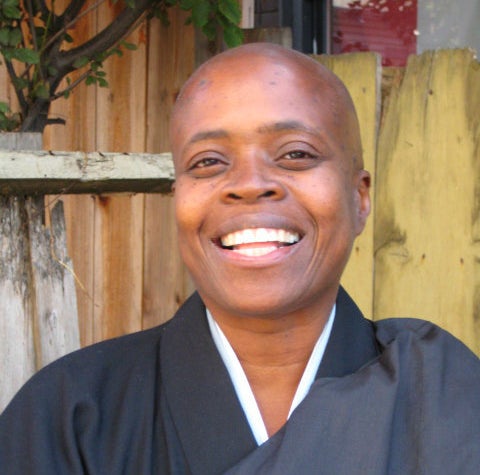
OAKLAND, Calif. (RNS) When Zenju Earthlyn Manuel goes to teach somewhere for the first time, she often sees surprise in the faces of the students as she is introduced.
She doesn’t look like many of them expect. She isn’t Asian. She isn’t a man. And she isn’t white.
And getting them to acknowledge that her body — her “manifestation,” as she calls it — is different and a part of her experience is crucial to her teaching. If our bodies are sources of suffering, then we ignore them at our peril.
“When I have held and embraced who I am, how I am embodied, it has become a source of enlightenment, of freedom,” she said from a sunny corner window seat in her living room. Draped in a black monk’s jacket, she is a stark contrast to the white walls and white upholstery of the rest of the room.
It is an idea that she unpacks in “The Way of Tenderness: Awakening Through Race, Sexuality, and Gender,” her second book of dharma, or Buddhist teachings, published in February by Wisdom Publications. In it, Manuel, who follows the Zen tradition, calls on Buddhists not to ignore those ways they may be different, whether it’s because of their color, gender or sexual orientation.
“These are the things you were born with,” she said, one hand resting on her chest. “Do you curl up and die or do you live with it?”
This idea — which she and others call a “multiplicity of oneness” — is somewhat controversial within Buddhism, where the teachings have tended to focus on moving beyond the physical to find the spiritual. But Manuel and a handful of other Western Buddhists — including a number of African-American teachers — are embracing the idea as crucial to enlightenment, a state free from anxiety that is the ultimate goal of Buddhism.
“There are two truths in Buddhism; one is relative and one is absolute,” Manuel said. “We tend to want to be in the absolute, where we are all the same, we are all one. But that is not where our suffering lies. Our suffering lies in the relative truth, in how we are embodied. So we have to acknowledge and explore these bodies to experience the absolute truth, the truth that we are one from the source of life. We can’t skip it.”
Jan Willis, a religion scholar and author of “Dreaming Me: Black, Baptist and Buddhist,” said Manuel’s teachings might be considered controversial in mainstream Buddhism but cannot be ignored.
“Within the United States (Buddhist community), and especially from male convert practitioners, you hear, ‘You are making too much of that body and if you are really a Buddhist you have to transcend that,'” Willis said. “She is calling them on that. She is saying you have to deal with this first. And you do. When a black female lesbian body sits on a cushion, that is where her practice starts from, and you better take that into account.”
Manuel, 62, has had a multiplicity of lives, all of which inform her work. She is reluctant to discuss particulars, but her writings hint at violence, poverty and prejudice in her Southern California childhood. She has been an activist since the tumultuous 1970s — a way to vent her rage and frustration at the plight of American blacks — and has also known fear and rejection because she is bisexual.
She was raised a Christian but discovered Buddhism in 1988 when friends insisted she come to a meditation before they could go to dinner. She was hungry so, OK, I’ll meditate and then let’s eat, she recalled. A month later, she had her own Buddhist altar and sitting meditation practice.
But no amount of meditation erased her pain, she writes. At first, teachers suggested if she “dropped the labels” of African-American, of bisexual, of woman, she would “be liberated.” She wasn’t. She finally found what she calls “complete tenderness” — the experience of walking through her pain, knowing it, living with it, but not being controlled by it — by confronting her suffering caused by her upbringing and identity as an African-American bisexual woman.
Upon her ordination as a Zen Buddhist priest, she was given the name “Zenju,” which means “complete tenderness.”
Now, Manuel teaches a small circle of students, all of them people of color and most of them women, from her home above the Oakland flats. A small jade statue of Kuan Yin, a figure of mercy, shares a mantel niche with a figure of the Virgin Mary, a nod to her partner’s childhood Catholicism. Pride of place goes to an alabaster carving Manuel made of a wide-eyed woman emerging from the unforgiving rock.
“Women, people of color, anyone who is marginalized, who might be murdered for who they are — how does that group of people live a full life?” she asked. “That has always been my question and it is ongoing.”
Also on HuffPost:
